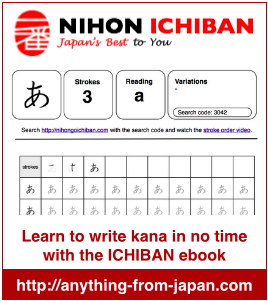Minasan, konnichiwa! Mike desu. It’s been a while since my last post, and that is because life has gotten incredibly busy. My wife and I are expecting our first child in August, so as you might imagine, my Japanese studies have taken a backseat to trying to get everything ready for our new arrival. It’s an exciting time, but also one where free time is in very short supply.
So I’m going to steal away some time during my lunch break to write this post. It concerns an issue that every beginning Japanese student has to face at some point if he or she wants to move beyond the most basic understanding of the language. Yes, I’m talking about those incredibly complex, multifaceted and often infuriating Chinese characters called kanji.
The very first question one might have when confronting kanji is: Why? The Japanese already have two writing systems, hiragana and katakana, for any syllable that can be uttered in the language. Aren’t those enough to go around?
Well, you could technically write any Japanese sentence in nothing but kana. But, believe it or not, that can actually be more tiring (and more confusing) to read. That is because each kana only represents one syllable, whereas kanji can contain multiple syllables in them. For example, take the very simple word for teacher, “sensei.” If you were writing this in kana, it would take four kana in sequence: se, n, se, i. Meanwhile, it only takes two kanji (sen, sei). So already, you’ve doubled your reading speed.
Another advantage is immediately understanding the meaning from the characters. Kana mean nothing on their own; they’re just sounds. Meanwhile, kanji have their meanings built right in. This helps avoid mistakes with words that sound the same, such as “hana.” The word looks the same written in kana, but in kanji can mean either nose or flower depending on the character.
Kanji is starting to sound like an incredibly useful system, isn’t it? There are a few caveats, though:
First, just because you are reading faster does not necessarily mean you are writing faster. That is one of the quirks of Japanese. Using my earlier example, “sensei” in kana takes nine strokes to write. But in kanji, though it is only two characters, it takes 11 strokes. And that is a minor example. For instance, take the Japanese word for love, “ai.” In kana, it’s five strokes. In kanji, that lone character of “ai” takes 13 strokes.
The other big hurdle of kanji is that the characters often have multiple sounds associated with them. Specifically, kanji can have both on readings (which are based on the Chinese pronunciation of the character when that character was first absorbed into the Japanese language; it is not necessarily the same sound in modern Chinese) and kun readings (the native Japanese pronunciation).
What’s more, kanji can have multiple on and kun readings depending on context and whether or not the character is used in a name. There are a few rules of thumb to figure out the correct pronunciation to use. Often, when you see three or more kanji jammed together, the characters are going to take an on reading, and when you see the character by itself or with kana trailing off the end of it, it’s going to take a kun reading. But guess what? Those are not hard and fast rules. In fact, there are so many exceptions to them and irregular pronunciations that before long you will probably throw those rules out the window and most likely feel overwhelmed and lost.
However, there is hope. And that is this: Practice, practice, practice. Find ways to use kanji in daily life and write them out whenever you can (this is something I will get more into in a future post). The language probably seems completely arbitrary in its rules, but in that way, it is like pretty much any language.
For example, consider this: Comb, tomb, bomb. Or this: Predict, indict. There is nothing in the words themselves that tell you the pronunciations are drastically different. Non-native English speakers would see those words, their similar spellings, and probably think they all have similar sounds. But you know how different they are. How? From being exposed to them, practicing them, hearing them and using them. It’s the same with kanji. My feeling is, if you can master a language as arbitrary as English, you can do it again with Japanese.
As always, I am interested in what you have to say and your experiences as well. Are there any podcasts you recommend for learning about Japan and the Japanese language? Let me know.
 Did you like this post? Click here to read more from our Guest Writer Mike.
Did you like this post? Click here to read more from our Guest Writer Mike.


Hi Mike, Thanks for the post. I’ve taken JLPT5 and did well and I’m currently working through JLPT4’s kanji. I already have around 5 or 600 Kanji, I really enjoy learning them. I like the kun and on reading tip, thanks for that! I hadn’t noticed that before. A tip for learning Kanji is to go into those hyaku en shops and pick up the childrens kanji books for 100en. Although the Kanji are basic to start off with, the reading absolutely isn’t, especially for a begineer of less than 3 years. The kids already know the language so they aren’t afraid to throw curve balls at them, and every page will be littered with readings/vocab/verbs you don’t know, but the 4 year old kids do because they are speaking the language every day. For example, I opened a new one the other day, Kanji basic 1 with a picture of a cute bunny on the cover and kanji written in kana. The first Kanji was 川 very basic, of course but it was contained within a sentence, 川がながれる, I didn’t know the verb ‘to flow’ prior to that. Then some of the Kanji that are considered basic to kids, we might not see until JLPT 3 or 2, but it explains them easily and quickly (The book is for 4 year olds). I highly recommend these. And Heisig. And pictographix! I’ll stop now..
Ste-san, thank you for the reply. I don’t live in Japan, so do not have access to those wonderful hyakuen shops. However, I took your suggestion to heart. I found some bilingual Japanese/English children’s books online, ordered a couple, and am looking forward to cracking them open and learning more. Thanks for the tip!
I’m using children’s kanji learning books too, they are really good because they are completely in Japanese, but easy to read if you’re already used to kana and will really help you pick up vocabulary. If you are near any Japanese bookstores you can find them, I got some at Kinokuniya in NY and Sanseido near Mitsuwa in NJ, and you can find them online to order also, I ordered one from here http://www.jlist.com/product/ASA051.
konnichiwa Mike, 1st of all congratulations to you & your wife!! I must say this is amazing post. Very useful for non-native Japanese learners as Kanji is the most difficult part while learning Japanese… Thank you very much for sharing valuable tips!!
Ashwini-san, thank you. I am glad you are finding these tips helpful. I will share some more when I have some time to write another post. And thank you for the congratulations regarding the baby on the way. We are very excited.
Thanks Mike. I’ve been studying for the Kanken test (“Kanji Kaiten”) which is taken by some schoolchildren to show they have mastered the kanji which are expected for each grade level. First grade (Kanken 10) has 80 basic kanji, 2nd grade (Kanken 9) has 160 more, and then more and more after that.
In studying for this test, you have to understand the meaning and stroke order for the kanji you are studying, as well as the pronunciations that gradeschool kids are expected to know, up to 4 different readings per kanji I’d guess. One example I just ran into yesterday (I’m studying with my daughter) was for AME 雨 (rain). Her practice book showed a word 雨かっぱ which means raincoat and is pronounced AMAkappa.
The point is, you have to understand and learn some vocabulary to successfully complete the test. First time I took Kanken 10, I got 140 out of 180 points. Sadly, 150 was passing. 😦 But I’ll try again.
The stroke orders I learned from Heisig, and that’s been really wonderful. I’ve actually interrupted my Heisig memorization to focus on the Kanken, but I’ll get back to it since it helps a LOT in memorizing the shape, meaning and stroke order of the kanji.
Another example: 竹林 (meaning “bamboo grove”) can be pronounced BOTH as “chiku-rin” or “take-hayashi”, meaning the same thing!
Thanks
Darryl
Ganbatte, Darryl-san! That test sounds extremely involved, so best of luck to you. Kanji can be a trial sometimes, especially with all the exceptions to pronunciation that upset the carefully laid out rules we memorize. It’s a challenge, but it’s also a lot of fun. Let me know how you do on your next test. Also, I have heard a lot of recommendations about Heisig. I might need to look into that.
And if anyone wants to continue the conversation about Japanese practice tips, you guys can follow me on twitter @isnotsparta. Mata ne!
Hi,I m one of admins of FB page “Let’s learn Japanese Language Together”.I shared your this article today. Your site is very helpful for Japanese learners.
omg,my FB page Is “Let’ learn Japanese together”*
Arigatou gozaimasu, Tomoko-san. I follow that Facebook page all the time, and am delighted to hear that you found my guest blog worthy of reposting there.